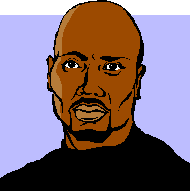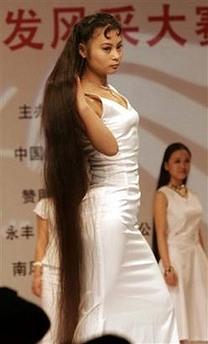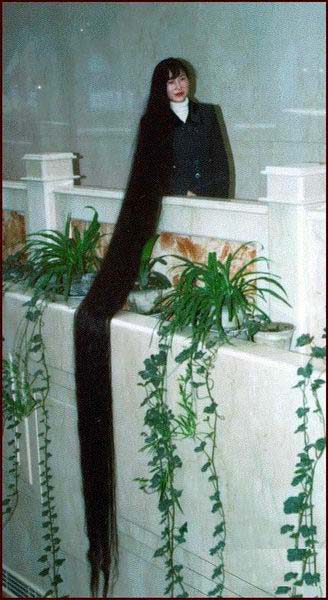Hair's the Facts Ma'am
Bouncing Back: Healthy HairHow you lose or keep your hair depends on how wisely you choose your parents. - Edward R Nida by Elizabeth Francke Egyptians solved their hair problems - heat, dryness, lice and dirt - by shaving off all their body hair and wearing wigs instead. Even the beards worn on ceremonial occasions by kings, and also sovereign queens, were false. Only priests, barbers and labourers are sometimes shown completely hairless. Egyptian wigs were made of real hair sometimes mixed with wool or plant fibres. They were ventilated for coolness, and fitted to the head with linen drawstrings. Dozens or hundreds of tight plaits, tiny spiral curls or frizzed locks were stitched down to the base, and when they fell below it, fixed permanently in place with bitumen or beeswax. Black or dark brown was the usual colour, though for a time around 1200 BC a few bold spirits wore wigs of blue, green or red. Sometimes the wigs were decorated with gem-set metal bands and ornaments of gold.
In a physical emergency life-sustaining chemicals go where they are most needed. When organs upon which life depends are actually threatened they need every scrap of nutrient that food or the body's stored reserves can supply - either to help them resist infection, heal themselves after injury, resist the devastating effects of general anæsthetics or very drastic medications like the chemicals used to fight cancer, or simply to continue functioning in times of malnutrition or severe stress. When this happens the less important organs, typically hair and fingernails, are deprived. From the onset of the emergency, each hair begins to grow thinner, weaker, and more brittle from its root. It may even fall out and not be replaced until general health is restored. Hair colour can be affected too. In times of stress the body uses up much larger than normal amounts of the B vitamins. These vitamins, especially the member of the group called PABA [para-amino-benzoic acid] are closely concerned with creating the colour pigments in hair. When the available B vitamins are urgently needed elsewhere the growing hairs can cease to have any colour pigment at all. So after a time of great stress or grief the hair may begin to grow through white. If this happens to quite young persons the colour can grow in again when peace of mind and health come back. But the natural loss of hair colour due to age seems inevitable, though it can perhaps be delayed somewhat by a diet especially rich in B vitamins.
I haven't cut my hair for over 10 years, but it comes only to the middle of my back. I know some people who have hair so long they can sit on it. Was all that hair able to grow in only 6 years? It seems it might've. The follicle and its papilla have a steady rhythm of growth and rest. In phase 1 the hair has fallen out. The follicle rests for a while. Then the action begins again. In response to some hormonal or other chemical trigger delivered by the blood the papilla stirs into activity. The follicle begins to grow down deeper into the subcutaneous tissue, rich in blood, and a new young hair begins to grow upwards to the surface of the scalp. If the old hair, now rootless because it is no longer connected to the papilla, is still hanging on in the follicle the vigorous new hair will soon push it out. This is why every healthy person with a full head of hair loses between 40 and 70 hairs a day. That is not only normal, it's necessary. Hairs aged and battered by several years of hard living are being replaced by new ones. In normal health the "growth" phase may last as long as 6 years, though in some individuals it may be as short as 2. Hair seldom grows faster than about 180mm (7") in a year. As people grow older the natural growth cycle slows down. Rest periods are longer, growth periods shorter, so even in women a very gradual slight thinning and shortening of the hair is to be expected in later middle age. This is usually hardly noticeable, except perhaps to the woman herself. The hair growing on your head is not alive. It is a non-living structure built by the living papilla at the base of every hair follicle, using materials delivered by the blood. This is no simple, brick-on-brick process, but an extremely complex chemical process that builds the whole three-layered structure of the hair and creates all its constituent compounds, of which the main one is keratin. Like all proteins, keratin consists of large, very complex long-chain molecules called amino acids. At least 18 different amino acids have been isolated from keratin. The main elements in hair are carbon, nitrogen, hydrogen, sulphur, phosphorus and chlorine, with water forming part of the molecular bond. Hair is elastic. A healthy hair will easily stretch by about 5% of its length and bounce back. When it is thoroughly wetted it will stretch much, much further, up to 25% of its length, shrinking back to its normal length as it dries. The elasticity of hair is the reason why it is possible to set it in temporary or permanent waves. Hair is hygroscopic, meaning that it absorbs water from a damp atmosphere (salt is the most annoyingly typical hygroscopic substance). Each hair soaks up water like a little sponge, and as it does so it softens and stretches. We set it in a curl or over a roller while it is in a softened, stretched condition. As it dries it shrinks and hardens again, it the new shape. When the hair is dry and the roller taken out you have a curl or wave that will last until the hair gradually absorbs moisture from the air and relaxes back into its natural degree of curl or straightness. Only "permanent" waving can alter the configuration of the hair's molecules by chemical means, reshape them and them fix them in the new shape permanently. Almost without exception the fancy ingredients in shampoos, described so lyrically on the labels, have been put there to make a more persuasive advertising or to provide a reason for designing prettier packs. (The pack is much more important than its contents when you're trying to sell shampoo.) They have nothing to do with the effect of the shampoo on the hair. The best thing any shampoo can do for any hair is to wash it completely and gently, without harming the scalp or causing the surface scales of the hair cuticle to lift and curl at the edges. Whatever hair-repair treatment may be needed or desirable is applied afterwards, by the conditioner, a different thing altogether. Fresh eggs make an ideal shampoo, though really long hair may use as many as 3 or 4 - a great extravagance. One old formula tells us to separate the eggs, beat both yolks and whites thoroughly as though you were making a sponge cake, then fold them into one another. The hair is thoroughly wetted and the creamy foam worked through a little at a time. Rinse very thoroughly with lukewarm water - if it is too hot you will have the fun of picking scrambled egg out of your hair. The very word "shampoo" implies a rough process. It comes from a Hindustani word, "champo", which is a command to "join, stuff, press, thrust in, shampoo; from the kneading or pressure used in the operation". This is obviously no way to treat a cashmere jersey, and it is no way to treat hair either, especially if it is in any way weakened by bleaching, perming or poor health. Hair should always be washed gently. One of the strange charms of life in icebound Greenland is that nothing gets dirty because there is no dust, so Eskimos presumably have no more need of shampoos than of vacuum cleaners. Though this book was ostensibly about hair, it contained some pretty good advice: The advice to "Take things easy!" and "Relax!" is about as useful as spitting into a hurricane, but you could try being as kind to yourself and as tolerant of others as you can, within reason. Happiness really is good for you. Not every moment of life is a competition; and, as Joe E Brown said in the immortal last scene of Some Like It Hot, when the girl he loved turned out to be Jack Lemmon in drag: "Nobody's perfect." It is very easy to drink too much coffee, and very unwise because the caffeine it contains destroys the B vitamins that keep the nerves steady. A heavy coffee-drinker should take a daily B-complex vitamin supplement. The carcinogenic substances from hair dye have been found in the urine of the user half an hour after she applied the dye to her scalp. With the approach of age, skin tones fade and soften. If hair colour keeps pace with this process, changing gradually from steel to silver as more and more white hairs appear among the dark ones, no unnatural contrast of an "old" face against "young" hair forces one to notice crow's feet and wrinkles. So now I have to be worried because my hair hasn't turned grey! Somewhere in this book I read where the chemicals that produce a permanent wave are the same ones used in depilatories to remove unwanted hair. If the neutraliser isn't applied in a timely manner, all the hair can fall out. About 20 years ago, I gave myself a permanent and left the solution on all night, thinking that would ensure my hair was seriously curly. It woke up disappointed because it didn't seem to help. I concluded that I had made the solution too weak. Thank goodness I did! Otherwise, I would probably have waked up bald. Source: Shampoo and Scissors: a Guide to Healthy and Beautiful Hair by Elizabeth Francke
The Biology of HairBeyond Rogaine: Zeroing in on the Molecular Switches that Regulate Hair Growthby Robert Kunzig The scalp is a small city populated by 150,000 individuals whose subcutaneous lives are only dimly comprehensible to us, whom they affect so much. The hair we see, fuss over, curse, write lyrics about, is just dead stuff, pushed up and out of the skin by the follicles below. It is those follicles that are alive, and that drive the growth and shedding we see. "The hair follicle is the only organ that regenerates in the adult in a cyclical way," says Bruno Bernard, head of hair biology research at L'Oréal, the French cosmetics manufacturer. "It is unique." In our follicles, cells still converse in the molecular language of the embryo; in our follicles we remain forever young. Most of us. In some of our follicles. And, of course, forever is a bit of journalistic license. For a long time most research focused on the dead part of hair - on understanding the physics and chemistry of the hair fibre with a view toward designing better shampoos, dyes, and perming agents. But recently the molecular biology revolution has come to the living follicle. In particular, says dermatologist Ralf Paus of the University of Hamburg in Germany, the ability to mutate or knock out certain genes in mice and to see what a mess that makes of their hair has allowed biologists to start picking apart the molecular clockwork that regulates follicle growth - with the ultimate goal of learning how to switch hair growth on and off. "There has been a huge technological advance," Paus says, "and that has made hair research so much more fun and so much more instructive than in all the decades before." To be sure, those earlier decades of research revealed the outlines of how hair grows. A hair follicle forms in the embryo - we are born with all the follicles we'll ever have - when the epidermis folds down into the underlying connective tissue, or dermis. The narrow pocket that results is filled with three concentric cylinders of epidermal cells; two root sheaths surround the hair shaft itself. At its base, which in growing adult hair is about a sixth of an inch below the skin's surface, the hair shaft envelops a little upraised nubbin of connective tissue called the dermal papilla. Hair grows right there, at the base - not at the tip, the way a plant does. Around and just above the dermal papilla, cells divide rapidly. As they are pushed upward by the swelling population underneath them, they make keratin, a helical protein. Four keratin helices twist around one another to form a protofibril. Eleven protofibrils form a cable called a microfibril, the microfibrils are bundled together into macrofibrils, and a bundle of macrofibrils fills each hair cell. By the time the cell has moved a fiftieth of an inch upward from the dermal papilla, it is so choked with keratin fibres that it is no longer exchanging material with its environment. That is, it is dead well before it even hits air. An individual hair typically grows for about three years, at a bit less than half an inch a month. So the maximum length a hair can reach is around a foot and a half. Obviously there are lots of atypical people. When the growth phase ends, the follicle rapidly shrivels and shrinks up toward the surface of the skin; within 3 weeks the hair's root is only a fiftieth of an inch deep. It now enters a rest phase of about three months in which a comb or even a stiff breeze will rip it out. Then, miraculously, the whole cycle begins again. The follicle grows back down into the skin, renews contact with the dermal papilla, and starts producing a new hair. Even more miraculous, the 100,000 to 150,000 follicles on your head are all cycling through these phases completely independent of one another. And that's a good thing: If the follicles were synchronised, our hairs would all fall out at the same time, and we would moult. Instead each individual follicle seems to have its own internal clock that drives it from growth to regression and back again. "We still have no clear idea whatsoever of what this molecular clock is," Paus says. "But it is fundamentally important to find out, because if we want to change hair growth in humans, it would be the ideal target."
Male-pattern baldness, as well as the more diffuse hair loss that some women suffer, are both caused ultimately by dihydrotestosterone (DHT), a metabolite of testosterone. DHT seems like a good idea in youth: It puts hair on male chests and faces, converting follicles that produced only peach fuzz, or "vellus" hair, into ones that produce the "terminal" he-man stuff. But for reasons that remain obscure, DHT has the opposite effect on some follicles of the adult scalp, presumably the ones that are genetically programmed to have more receptors for it. Finasteride, the big success story in the battle against baldness (Merck markets it as Propecia), works by blocking the enzyme that converts testosterone into DHT. In most cases, when men remember to take their pill every day, it stems the advancing tide of hairlessness; in some cases it causes moderate regrowth. In only a few cases - to those men it must seem a sad irony indeed - it causes a loss of sex drive and even impotence. The other irony is that the follicles make the crucial enzyme and thus DHT themselves. "They shoot themselves in the foot," Paus says. Why? That unanswered question is part of a bigger one. One of the most important recent advances in hair biology, Paus says, is the realisation that follicles are even more self-regulatory than anyone had imagined. A follicle doesn't just respond to hormones that wash over it through the bloodstream; it makes those hormones itself and presumably uses them for internal conversations. For instance, follicles make the same stress hormones that are made by the hypothalamus in the brain, the pituitary gland, and the adrenal gland. "That's absolutely wild!" Paus says. "That a complex signaling axis involving different organs of the entire body should be installed in all its elements in a mini-organ like the follicle - that's a wild concept." Hair follicles are us. Not just because they make the stuff we use to display our personalities; they are us in molecular microcosm. "This is the only organ that behaves this way," Bruno Bernard of L'Oréal says, showing off a petri dish in which an individual follicle is thriving in a bath of glucose, vitamins, and amino and fatty acids. "If you take skin or muscle or liver and put it in culture, it falls apart. Studying this little follicle is studying the human being - it's a very simple organ for understanding the big mysteries of biology." That's just one more reason, as if you needed one, to miss it when it's gone. Related Web Site - brush up on hair at L'Oréal's Hair Science Source: Discover Volume 23 Number 2 February 2002 © The Walt Disney Company
The Clean Pate Clubby Jonathan Yardley A review of the book Bald!: From Hairless Heroes to Comic Combovers by Kevin Baldwin Unless you are Yul Brynner or Telly Savalas, shaving your head for dramatic effect on the stage or on television, baldness isn't a matter of choice. Blame Mother Nature, blame God or your preferred Higher Power, blame your own all-too-mortal flesh - whomever or whatever you blame, in truth, it's completely beyond your control. As a little kid you had a nice head of hair (unless you are Sluggo in the "Nancy" comic strip), and as a teenager you had one, too, but somewhere along the way, much or all of it just began to disappear - and now here you are, as bald as a billiard ball, as a grapefruit, as an egg, as an ape, as a baby's bottom. All those examples are drawn from Bald! by Kevin Baldwin, an amusing and fairly encyclopædic inquiry into the universe of bald. The author, a British sportswriter, knows whereof he writes, as his photograph makes plain, and if this newspaper ran photos of its reviewers, you'd know that this one knows whereof he reviews. Baldness runs in my family the way thoroughbreds run at the track. In my living room hangs a portrait of one William Walton Woolsey, a direct forebear whose baldness must be seen to be appreciated, if not outright venerated. My father was bald well before his 40th birthday, my younger son well before his 30th. As for me, photographs of my crew-cut teenage self reveal a person whom I scarcely know since the only real me has been bald, bald, bald since the dawn of civilisation. This has never seemed to me a particularly big deal. Because my skin is fair, I wear hats at my dermatologist's urging, but since I like hats, that's fine. Otherwise, baldness is just another fact of life, the essential truth of which is that you get older and you die. Yet this is a reality that millions upon millions of people simply refuse to acknowledge, now as always, which explains Botox and Retin-A and Viagra and any number of scientific or pseudoscientific attempts to stave off the Grim Reaper, not the least of which are Rogaine, the brand name of minoxidil, and Propecia, the brand name of finasteride. These last two are the nostrums that untold millions of men have applied to their scalps in the fond hope of cajoling back into existence the hair that long ago went south, or north, or somewhere. There is precious little reason to believe that these cures really work - a study published in 1989 in the Journal of Clinical and Experimental Dermatology found, Baldwin writes, that Rogaine "might prove to be useful to only one person in 200" and would be ineffective "in the long term" - but the desire to cure baldness has nothing to do with reason and everything to do with our innermost selves. As Baldwin writes:
Well, this last may be just a wee bit over the top - baldness as self-definition? Get off it! - but the rest is right on the mark. The history of human responses to baldness is indeed a story of vanity and self-deceit, one that teeters along a fine line between the outrageous and the ridiculous. Doubters are advised to cast their eyes around the city in which these words are published, for surely Washington DC is the world capital of baldness denial. Most notably on Capitol Hill and along K Street NW, the parade of rugs, combovers and transplants is endless, notable as much for its transparent obviousness as for its ludicrousness. t should scarcely come as a surprise, though, that the center of world politics is also the centre of fake hair. "A combover is particularly inadvisable for anyone involved in politics," Baldwin writes. "As well as looking ridiculous, the wearer can appear misguided and even dishonest. To quote Philip II of Macedon: 'I could not think that one who was faithless in his hair could be trustworthy in his deeds.'" However ridiculous fake hair may be, politicians and other bigfeet just can't resist it. As Baldwin notes in his "Hairless History of the World" chapter, in an entry for 1942, when General Douglas MacArthur took command of Allied forces in the Pacific:
Connoisseurs of such inanity in the political world doubtless will recall the case of William Proxmire, a senator from Wisconsin and self-appointed national scold who attempted hair transplants and then went around with his wounded dome wrapped in a turban - which, as Baldwin correctly observes, made him look far more ridiculous than his baldness ever had. Baldwin does not mention, but should have, the parallel case of Joseph R Biden Jr, the perennially ambitious Democratic senator from Delaware, who doctored his hair in the 1980s; he was thought to have been grounded in the 1988 presidential race as punishment for swiping a political speech from Neil Kinnock, the (bald) leader of Britain's Labour Party, but the most telling evidence of a penchant for deceit was the mess of hair plugs in his skull. It was another famously bald politician, Adlai Stevenson, who, as Baldwin reminds us, "was just the sort of intellectual disliked ... by the American public." He "used long and abstruse words in speeches and made erudite references to French writers; the term 'egghead' was invented to describe him." But Stevenson, a man of great wit if little muscle, got the last laugh. "Eggheads of the world unite," he said. "You have nothing to lose but your yolks." As that suggests, humour is the best defense against those who would make fun of baldness, and Baldwin has assembled a useful collection of ripostes for the insulted:
He also writes an ingenious bald man's variation on Cyrano de Bergerac's incomparably witty speech ridiculing those whose mockery of his immense nose is crude rather than clever. It's too long to quote here, but you'll find it on page 132. Like just about everything else in this book, it's amusing, and it's dead on target. Source: washingtonpost.com 22 November 2005
Set Free
A girl shows her long hair during a national long hair contest Source: local6.com photo credit Associated Press/Xinhua taken by Chen Xiaogen
For articles related to lifestyles including guns, television, extortion, hair, handbags, parenting, time bind, desserts, fitness, feasting, friends, happiness, ageing and more,
click the "Up" button below to take you to the Index for this Lifestyles section. |
 Animals
Animals Animation
Animation Art of Playing Cards
Art of Playing Cards Drugs
Drugs Education
Education Environment
Environment Flying
Flying History
History Humour
Humour Immigration
Immigration Info/Tech
Info/Tech Intellectual/Entertaining
Intellectual/Entertaining Lifestyles
Lifestyles Men
Men Money/Politics/Law
Money/Politics/Law New Jersey
New Jersey Odds and Oddities
Odds and Oddities Older & Under
Older & Under Photography
Photography Prisons
Prisons Relationships
Relationships Science
Science Social/Cultural
Social/Cultural Terrorism
Terrorism Wellington
Wellington Working
Working Zero Return Investment
Zero Return Investment This book contained a sketch of a statue discovered in the Cyclades Islands. This statue,
which has been determined to be between 20 and 30,000 years old, is a 1" high bust of a charming young girl. Her shoulder-length hair is banded and fringed in a formal style.
This book contained a sketch of a statue discovered in the Cyclades Islands. This statue,
which has been determined to be between 20 and 30,000 years old, is a 1" high bust of a charming young girl. Her shoulder-length hair is banded and fringed in a formal style. My mother had grey hair as early as I can remember. In fact, one of my most vivid early
memories is isolating strands of her grey hair and pulling them out. She had heard that, where one grey hair was pulled, two black hairs would grow in. In reality, she was
just losing a lot of hair. I have no grey hair as yet, though I'm 20 years older than she was then.
My mother had grey hair as early as I can remember. In fact, one of my most vivid early
memories is isolating strands of her grey hair and pulling them out. She had heard that, where one grey hair was pulled, two black hairs would grow in. In reality, she was
just losing a lot of hair. I have no grey hair as yet, though I'm 20 years older than she was then. In some people, you see, the follicle clock runs faster. For 14 years in the 1980s and 1990s,
researchers at L'Oréal tracked 10 men month by month, shaving a square centimeter of their scalp and then watching to see how many of the 200 to 300 hairs in that patch grew
back. They found, not too surprisingly, that in men with incipient baldness, the average growth phase is shorter. Because a follicle probably has only a limited number of
cycles in it - a good guess is around 25 - the shorter the cycle, the sooner it will stop producing hair. That's what happens in most bald men: Their follicles live fast and die
young.
In some people, you see, the follicle clock runs faster. For 14 years in the 1980s and 1990s,
researchers at L'Oréal tracked 10 men month by month, shaving a square centimeter of their scalp and then watching to see how many of the 200 to 300 hairs in that patch grew
back. They found, not too surprisingly, that in men with incipient baldness, the average growth phase is shorter. Because a follicle probably has only a limited number of
cycles in it - a good guess is around 25 - the shorter the cycle, the sooner it will stop producing hair. That's what happens in most bald men: Their follicles live fast and die
young.
